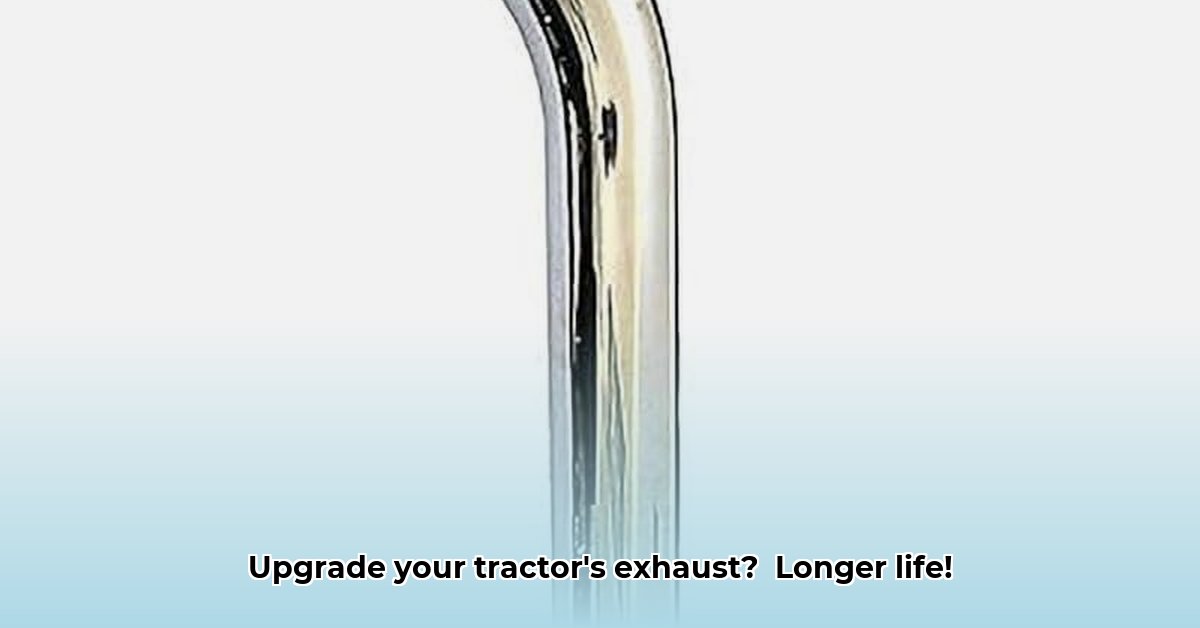
Chrome Exhaust Stacks in Agriculture: A Durability and Sustainability Analysis
Chrome exhaust stacks are a common sight on agricultural tractors, prized for their durability and ability to extend equipment lifespan. However, their contribution to overall sustainability is complex and requires a thorough examination. This article analyzes the market demand, performance characteristics, environmental impact, and sustainability considerations of chrome exhaust stacks, offering actionable advice for farmers, manufacturers, and policymakers. For more detailed information on chrome exhausts for tractors, see this resource.
Market Demand for Durable Tractor Parts
The market for durable aftermarket tractor parts, including chrome exhaust stacks, is substantial, as evidenced by numerous online listings for various tractor models (e.g., Farmall, Case IH). While precise market size quantification requires further research, the readily available online listings suggest significant demand across a broad range of agricultural operations. This highlights a key need for both robust and eco-friendly solutions. But how do these durable stacks measure up environmentally?
Durability and Performance: Chrome vs. Alternatives
Chrome exhaust stacks, often featuring 16-gauge plating (a nickel-chromium alloy), offer superior resistance to corrosion and wear. This translates to a longer lifespan compared to some alternatives, potentially reducing waste and replacement costs. However, the agricultural environment presents extreme challenges: constant exposure to dust, mud, extreme temperatures, and chemicals can stress even the most durable materials. Stainless steel, for example, offers comparable corrosion resistance and may even offer a longer lifespan, potentially offsetting a higher initial cost. More comprehensive comparative testing is needed to conclusively determine the superior material under these conditions. What are the long-term economic tradeoffs?
Environmental Impact of Chromium
The production and disposal of chromium present significant environmental concerns. Chromium mining and plating processes can lead to water and air pollution. Improper disposal of worn-out exhaust stacks further contributes to soil and water contamination. A comprehensive lifecycle assessment (LCA) is crucial to fully understand the environmental impact from raw material extraction through final disposal. This LCA would quantify the environmental burden compared to alternatives like stainless steel. Is the extended equipment lifespan enough to offset these environmental costs?
Sustainability Considerations and Best Practices
Moving towards a sustainable future requires a multifaceted approach:
- Exploring Alternatives: Research into alternative plating techniques and materials that offer comparable durability with a reduced environmental footprint is vital. Promising advancements are expected in the coming decade.
- Sustainable Manufacturing Practices: Manufacturers can implement processes to minimize waste and pollution during production and plating, reducing the overall environmental impact.
- Responsible Recycling Programs: Developing and implementing robust recycling programs for end-of-life exhaust stacks is critical to recovering valuable materials and preventing environmental contamination.
Actionable Steps for Stakeholders
To foster a more sustainable approach, all stakeholders must take decisive action:
- Equipment Manufacturers (OEMs): Invest in research and development of truly sustainable exhaust systems. Explore eco-friendlier materials and plating techniques. Consider offering extended warranties to incentivize longer equipment use.
- Aftermarket Parts Suppliers: Conduct LCAs on their products. Transition to more environmentally conscious materials and manufacturing processes. Promote responsible disposal methods.
- Farmers/Agricultural Businesses: Factor in the overall lifecycle cost of parts, considering not only initial price but also long-term durability and environmental impact. Support businesses committed to sustainable practices.
- Regulatory Bodies: Implement stricter regulations on chromium waste management and encourage innovation in sustainable materials and manufacturing. Incentivize the adoption of eco-friendly alternatives.
Regulatory Landscape and Future Outlook
The regulatory landscape surrounding chromium use and waste management is constantly evolving. Staying informed about current and future regulations is crucial for all stakeholders to ensure compliance and responsible practices. Proactive engagement with regulatory bodies can help shape policies that promote sustainable agricultural practices. What incentives will drive adoption of more sustainable materials?
Conclusion: A Greener Future for Agriculture
The choice of exhaust stacks in agriculture involves balancing durability with environmental responsibility. Though chrome's durability extends equipment life, reducing waste, its environmental impact cannot be ignored. A collaborative approach—embracing sustainable alternatives, responsible disposal, and proactive regulation—is essential for a future where agriculture thrives without compromising the planet's health. Continued research and development of sustainable materials are crucial to achieving this goal.